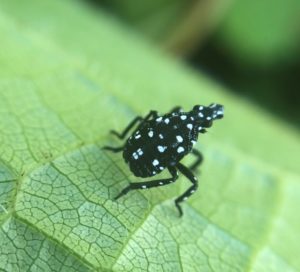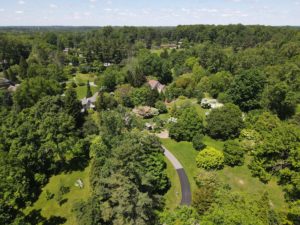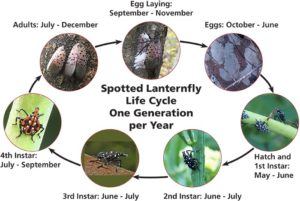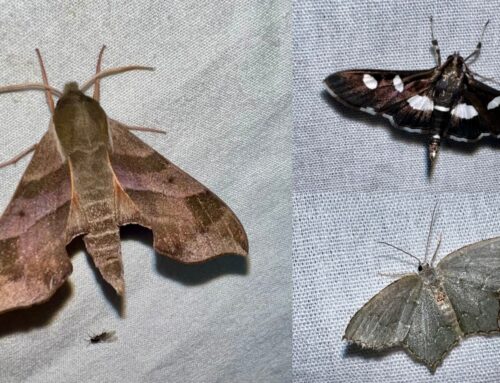The spotted lanternfly (Lycorma delicatula) is back in force here at Tyler Arboretum and everywhere else in Delaware County! Picture above is the nymph stage which is its current appearance.
The spotted lanternfly story began, in some ways, here in Philadelphia in 1784. That was the year when the tree of heaven (Ailanthus altisima) was introduced. Originally valued for its rapid growth and tolerance of poor sites, tree of heaven is a prolific seeder and rapid colonizer that springs up to fill areas where other trees have been cut down. People thought that this was the answer to erosion control and to produce quick shade cover. These characteristics made it uniquely able to march across America right alongside the pioneers, eventually reaching the West Coast in 1850.
In addition to being listed as a noxious weed, tree of heaven is also the preferred host for the spotted lanternfly. When this insect hitched a ride across the world in 2014, it arrived in the US to find a forest already filled with its favorite food. While they can certainly feed (sucking plant sap) on a wide variety of plants, and can even rely on several different species to reproduce, the spotted lantern fly strongly prefers tree of heaven. They will seek out tree of heaven to feed before their final instar (growth phase in between two moltings) in order to reach the adult phase and lay their eggs.
The spotted lanternfly’s preference for tree of heaven actually gives us a leg up in our management strategy as well as a way to solve two problems at once. Tree of heaven is what’s known as a dioecious species, meaning that there are separate male and female trees, so forest managers can cut down the female trees and leave male trees standing to act as “bait trees” for the lanternfly. This approach will stop the spread of tree of heaven seeds and allow management teams to treat the male trees with a systemic insecticide that will stop the lantern flies when they feed. Spotted lantern flies breed only once a season in our area. They hatch from their eggs in the spring and spend all summer reaching their final instar. They lay their eggs in the fall to overwinter and hatch as next year’s generation, so the more we can limit their reproductive success in the fall the more we’ll reduce next year’s population.
Tyler’s battle with the spotted lanternfly began in 2018 when the first mature insect was discovered on the property. Since then the Arboretum has worked hard to remove tree of heaven on property. Officials from the state spent most of the summer of 2018 carefully surveying the property to get an accurate assessment of the current spotted lanternfly and tree of heaven population. Then we went to work removing trees. There are still 20 large specimens standing on the property, some of which we have treated and are monitoring closely. As of February of 2020 we’ve seen good evidence that all of the remaining tree of heaven have been visited by the spotted lanternfly in the summer of 2019. Even more promising the damage seemed less severe on treated trees, which gives us a clue that we may be having some effect!
These are big management projects that Tyler’s taken on, and in these uncertain times we don’t know what sort of state or federal support may exist to help control these pests. The threat posed to the trees at Tyler may not be as economically costly as the threats faced by farmers with fruit trees, but it’s potentially detrimental to our woods and collections. Imagine if our tulip trees were in bad health or our majestic beeches no longer provided shade! We take our responsibility to protect our historic collections seriously and could really use your help. To learn more about how you can donate to Tyler to help us combat this invasive pest please click here.
And when you come in for a visit, keep your eyes peeled. If you see any spotted lanternflies do your part to protect the Arboretum….and step on those bugs! A good old fashioned stomping is an effective way to help rid these insects. Know what they look like before you step on any bug, less you harm the good guys. Currently at the time of this blog, the spotted lanternfly is seen as a white spotted, black nymph with no red markings. At this point they may range from ¼” to ¾” in length.
Lifecycle courtesy of New York State Integrated Pest Management
Addendum:
Spotted lanternfly has a large palette of plants that they will feed on and some of them are agriculture crops in PA. Of significance are grapes, apricots, plums and peaches. At Tyler, our collections and woods are in danger as they also prefer the following:
American beech (Fagus grandifolia)
American linden (Tilia americana)
American sycamore (Platanus occidentalis)
Big-toothed aspen (Populus grandidentata)
Black birch (Betula lenta)
Black cherry (Prunus serotina)
Black gum (Nyssa sylvatica)
Black walnut (Juglans nigra)
Dogwood (Cornus spp.)
Japanese snowbell (Styrax japonicus)
Maple (Acer spp.)
Oak (Quercus spp.)
Paper birch (Betula papyrifera)
Pignut hickory (Carya glabra)
Sassafras (Sassafras albidum)
Serviceberry (Amelanchier canadensis)
Slippery elm (Ulmus rubra)
Tulip poplar (Liriodendron tulipifera)
White ash (Fraxinus americana)
Willow (Salix spp.).
For more information about identification, reporting process and control, go to the Penn State Extension service or the PA Department of Agriculture.









